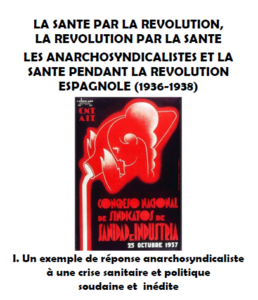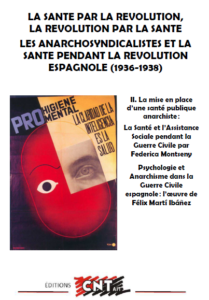Health questions have played a very big role in the structuring of anarchist thought in Spain, since its appearance at the end of the 19th century. Health professionals, doctors, nurses, nursing assistants, pharmacists … have played a very active role in framing the anarchist movement, from an ideological, theoretical, practical and organizational point of view.
This phenomenon is not exclusive to Spain. In all the countries where anarchist ideas have taken root, it is common to find health professionals (sanitarios) among its activists. It is even logical: doctors and other health workers were the direct witnesses of the effects of the industrial revolution on the living and working conditions of the proletariat. Often in their publications they propose measures to solve these health problems, which are real social epidemics. Some even consider that the only possible therapy to social diseases is the radical transformation of society.
But in Spain, the participation of « sanitarios » in the anarchist movement has known truly structuring proportions. The book « the finality of the CNT-AIT, Libertarian Communism« , a true reference compass of the Spanish anarcho-union movement, has been written by the doctor Isaac Puente, including Federica Montseny – future anarchist minister of health – could say: « indisputably, Doctor Isaac Puente was the main inspirer of the collective achievements of the Spanish Revolution« .
The specificity of the Spanish anarchist movement, particularly in the health sector, is that it tried to apply, on a large geographical scale, the anarchist principles and to confront them with reality, even if it was under the conditions appalling civil war, which made health problems even more acute (war wounded, refugees, shortages of personnel and equipment, risk of epidemics, etc.).
Witness to this intense participation of health professionals in the Spanish anarchist movement, the Spanish libertarian press, whose number of titles continues to surprise current historians and activists, has collected a large number of articles, information, readers’ letters and lectures given by health professionals in athenaeums (libertarian social centres). This does not mean that all of the authors of these articles, not even the majority surely, shared the entirety of the anti-authoritarian ideas of the papers in which they wrote, but they knew that this was the most direct way to bring their ideas closer to the most active part of the proletariat. There were reciprocal influences between the anarchosyndicalist movement and popular health movements of other obedience – socialist in particular – so much so that during the Revolution of 1936, the global vision of the organization of revolutionary health was generally shared. And orientated toward an anarchist sense, of a socialized (not necessarily state-owned), universal, secular and free health system, with an integrated health system, leaving more to health prevention.
This 2-part brochure series tries to shed light on what has driven these hundreds and thousands of activists over more than a century: mutual aid and solidarity, humanism above all. They were convinced that the best therapy in the face of a sick society is still the social and anarchist Revolution.
The objective of this work of compilation of texts, written by activists in the heat of the moment or by academics several decades after the revolutionary passion has died down, is not to indulge in the nostalgia for a lost Utopia that would never come back.
As Humanity is shaken by a health crisis, which turns into a major political and economic crisis which is said to herald a change in the organization of the world; it seems essential to us to return to this period of the Spanish Revolution, which we know was the harbinger of subsequent world upheavals.
It is fashionable among academic, academic, journalistic and political commentators to say that Anarchy is a situation of absolute disorder, and that Anarchists are at best soft dreamers, at worst dangerous thugs. The crisis we are currently experiencing with Covid 19 shows us on the contrary that the absolute disorder we are currently experiencing is not Anarchy but chaos, and that it is not the result of an anarchist policy, but the combined result of the action of Capitalism and the State.
The experience of the CNT-AIT in Spain shows us that – faced with a situation as sudden as that of Covid-19, the anarchosyndicalist movement nevertheless managed to revive the health system almost immediately, and this when most of the health executives had fled and while they were absolutely lacking all. The difference comes from the fact that if the crisis (the Revolution) had not been foreseen by the anarchists (the triggering factor came from a fascist coup d’état which had not been announced), at least had it they predicted – and even called out – and so they had patiently organized themselves, for more than 70 years, to be ready, when the day came, to face it. This is what Capitalism and the state lack in dealing with epidemics: the sense of History. However, we know that in the event of an epidemic, the key factors to prevent its spread are preparedness, early detection and rapid reaction. And that it is not in time of « war » that these skills are prepared. Spanish anarchosyndicalist activists have shown their ability to anticipate and prepare; and if the Spanish revolution led to a major political crisis and a Civil War, at least ones must recognize that it did not lead to a global sanitary crisis since – as long as the anarchists were responsible for the health of the population in the Republican zone, no epidemic was to be deplored, and this to the astonishment even of the best world specialists who had come to inspect the situation expecting to find an explosive health situation.
If we compare what the Spanish workers, peasants (often illiterates), and a few doctors and nurses who remained were able to accomplish in such a short time in 1936 wartime, with the facts that in 2019, to deal with COVID 19, the French army’s health division, which costs millions of euros and which has a profusion of equipment and personnel, has not been able to set up a Barnum tent with 30 resuscitation beds in less than 3 weeks at the beginning of the epidemic, then we cannot prevent thinking that yes, definitely, Anarchy is the highest expression of Order, and that it would be desirable for our health and the well-being of humanity and the planet, that we take example on the Spanish revolutionaries of 1936…
The anarchist definition of health is “Total state of well-being, physical, mental and social” ”. To reestablish Harmony, between humans as with the Planet, a sine qua non condition for living in full health, we must put an end to Capitalism and the State. It’s urgent.
Some CNT-AIT France health workers
The 2-parts brochures (in French) can been download. Paper copy can be sent on request to contact@cnt-ait.info
Volume I. An example of anarchosyndicalist response to a sudden and unprecedented health and political crisis

– INTRODUCTION: Health through Revolution, Revolution through Health
– Some precursors: anarchist critiques of medicine
– Brief historical panorama of anarchist health in Spain
a) The beginnings of the First International in Spain (1870-1900): the rational and scientific bases of Spanish anarchism
b) The contributions of neo-Malthusianism and naturism (1900-1920)
c) During the dictatorship of Primo de Rivera (1923 – 1931): maturation of previous ideological contributions
d) The Second Republic (1931-1936): affirmation of libertarian communism as the goal of anarchosyndicalism and a remedy for social diseases
e) The Social Revolution (1936-1937): putting into practice 70 years of conceptual and ideological preparation.
f) The Order against Sanitarian and Social Utopia: the Communists then the exile, internal resistance, underground (1938-1975)On the role of technicians in the revolutionary period (Gaston Leval)
Anarchosyndicalism and health behind and at the front: the case of Valencia and the Iron Column in the Spanish Civil War ((1936-1937)
« Health, performance and activity »! The Workers’ Health Organization, the CNT-AIT and the collectivization of medico-health services at the start of the revolution in Barcelona
The CNT-AIT field hospital in Villajoyosa (Alicante)
« In the hospital … » (text from Arbetaren, 1936)
– CNT-AIT posters in support of field hospitals, witnesses of the Revolution and the Spanish Civil War
Volume II: An attempt of implementation of an anarchist public health:

TABLE OF CONTENTS
– Spanish anarchism in the health debate in Spain: health, disease and medicine (1930-1939)
1. Introduction: the debate around health, sanitation and hygiene
2. The CNT and the concept of social medicine
3. The anarchist discourse on “social diseases”
4. The health problem during the civil war: the CNT and the Catalan health control
– Towards a Definition of Anarchist Health: The National Health Congress of March 1937
Purpose: health from an anarchist point of view
Principle: The health system from an anarchist perspective
Tactics: implementation of principles to achieve goal
– Health in the Social and Libertarian Revolution of 1936
– Health and Social Assistance during the Civil War by Federica MONTSENY (1986)
Organization of the Ministry of Health
The League of Nations Health Committee
Social Assistance
Invitation of the League of Nations Health Committee
Creation of the Central Office for Evacuation and Assistance to Refugees
The problem of abortion; The fight against prostitution
– Psychology and Anarchism in the Spanish Civil War: the work of Félix Martí Ibáñez
Martí-Ibáñez and psychology before the civil war
The reform of psychiatry during the civil war
Psychoanalysis of the Civil War
The psychological work of an exile